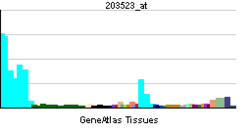LSP1
Lymphocyte-specific protein 1 is a protein that in humans is encoded by the LSP1 gene.[4][5]
This gene encodes an intracellular F-actin binding protein. The protein is expressed in lymphocytes, neutrophils, macrophages, and endothelium and may regulate neutrophil motility, adhesion to fibrinogen matrix proteins, and transendothelial migration. Alternative splicing results in multiple transcript variants encoding different isoforms.[5]
References
Further reading
- Jongstra-Bilen J, Young AJ, Chong R, Jongstra J (1990). "Human and mouse LSP1 genes code for highly conserved phosphoproteins". J. Immunol. 144 (3): 1104–10. PMID 2295815.
- Klein DP, Jongstra-Bilen J, Ogryzlo K, et al. (1989). "Lymphocyte-specific Ca2+-binding protein LSP1 is associated with the cytoplasmic face of the plasma membrane". Mol. Cell. Biol. 9 (7): 3043–8. PMC 362773
 . PMID 2674678.
. PMID 2674678.
- Li Y, Guerrero A, Howard TH (1995). "The actin-binding protein, lymphocyte-specific protein 1, is expressed in human leukocytes and human myeloid and lymphoid cell lines". J. Immunol. 155 (7): 3563–9. PMID 7561054.
- Misener VL, Hui C, Malapitan IA, et al. (1995). "Expression of mouse LSP1/S37 isoforms. S37 is expressed in embryonic mesenchymal cells". J. Cell. Sci. 107 (12): 3591–600. PMID 7706408.
- Maruyama K, Sugano S (1994). "Oligo-capping: a simple method to replace the cap structure of eukaryotic mRNAs with oligoribonucleotides". Gene. 138 (1–2): 171–4. doi:10.1016/0378-1119(94)90802-8. PMID 8125298.
- Howard T, Li Y, Torres M, et al. (1994). "The 47-kD protein increased in neutrophil actin dysfunction with 47- and 89-kD protein abnormalities is lymphocyte-specific protein". Blood. 83 (1): 231–41. PMID 8274738.
- May W, Korenberg JR, Chen XN, et al. (1993). "Human lymphocyte-specific pp52 gene is a member of a highly conserved dispersed family". Genomics. 15 (3): 515–20. doi:10.1006/geno.1993.1102. PMID 8468046.
- Thompson AA, Omori SA, Gilly MJ, et al. (1997). "Alternatively spliced exons encode the tissue-specific 5' termini of leukocyte pp52 and stromal cell S37 mRNA isoforms". Genomics. 32 (3): 352–7. doi:10.1006/geno.1996.0129. PMID 8838798.
- Huang CK, Zhan L, Ai Y, Jongstra J (1997). "LSP1 is the major substrate for mitogen-activated protein kinase-activated protein kinase 2 in human neutrophils". J. Biol. Chem. 272 (1): 17–9. doi:10.1074/jbc.272.1.17. PMID 8995217.
- Suzuki Y, Yoshitomo-Nakagawa K, Maruyama K, et al. (1997). "Construction and characterization of a full length-enriched and a 5'-end-enriched cDNA library". Gene. 200 (1–2): 149–56. doi:10.1016/S0378-1119(97)00411-3. PMID 9373149.
- Palker TJ, Fong AM, Scearce RM, et al. (1999). "Developmental regulation of lymphocyte-specific protein 1 (LSP1) expression in thymus during human T-cell maturation". Hybridoma. 17 (6): 497–507. doi:10.1089/hyb.1998.17.497. PMID 9890705.
- Pulford K, Jones M, Banham AH, et al. (1999). "Lymphocyte-specific protein 1: a specific marker of human leucocytes". Immunology. 96 (2): 262–71. doi:10.1046/j.1365-2567.1999.00677.x. PMC 2326732
 . PMID 10233704.
. PMID 10233704.
- Zhang Q, Li Y, Howard TH (2000). "Human lymphocyte-specific protein 1, the protein overexpressed in neutrophil actin dysfunction with 47-kDa and 89-kDa protein abnormalities (NAD 47/89), has multiple F-actin binding domains". J. Immunol. 165 (4): 2052–8. doi:10.4049/jimmunol.165.4.2052. PMID 10925289.
- Zhang Q, Li Y, Howard TH (2002). "Hair-forming activity of human lymphocyte specific protein 1 requires cooperation between its caldesmon-like domains and the villin headpiece-like domains". Cell Motil. Cytoskeleton. 49 (4): 179–88. doi:10.1002/cm.1031. PMID 11746662.
- Strausberg RL, Feingold EA, Grouse LH, et al. (2003). "Generation and initial analysis of more than 15,000 full-length human and mouse cDNA sequences". Proc. Natl. Acad. Sci. U.S.A. 99 (26): 16899–903. doi:10.1073/pnas.242603899. PMC 139241
 . PMID 12477932.
. PMID 12477932.
- Wong MJ, Malapitan IA, Sikorski BA, Jongstra J (2003). "A cell-free binding assay maps the LSP1 cytoskeletal binding site to the COOH-terminal 30 amino acids". Biochim. Biophys. Acta. 1642 (1–2): 17–24. doi:10.1016/S0167-4889(03)00082-X. PMID 12972289.
- Ota T, Suzuki Y, Nishikawa T, et al. (2004). "Complete sequencing and characterization of 21,243 full-length human cDNAs". Nat. Genet. 36 (1): 40–5. doi:10.1038/ng1285. PMID 14702039.
- Harrison RE, Sikorski BA, Jongstra J (2005). "Leukocyte-specific protein 1 targets the ERK/MAP kinase scaffold protein KSR and MEK1 and ERK2 to the actin cytoskeleton". J. Cell. Sci. 117 (Pt 10): 2151–7. doi:10.1242/jcs.00955. PMID 15090600.
- Hassel S, Eichner A, Yakymovych M, et al. (2004). "Proteins associated with type II bone morphogenetic protein receptor (BMPR-II) and identified by two-dimensional gel electrophoresis and mass spectrometry". Proteomics. 4 (5): 1346–58. doi:10.1002/pmic.200300770. PMID 15188402.

 . PMID 2674678.
. PMID 2674678. . PMID 10233704.
. PMID 10233704. . PMID 12477932.
. PMID 12477932.